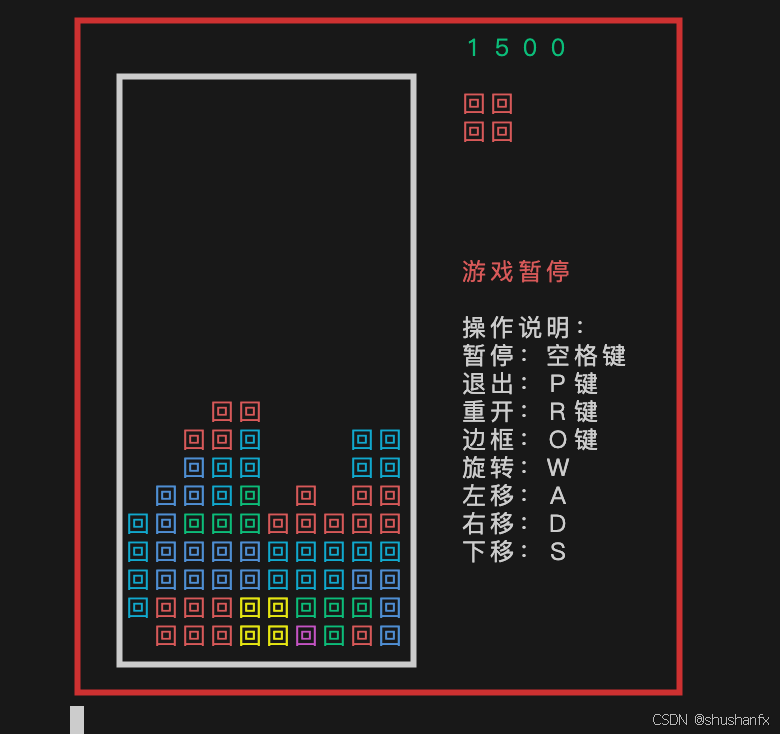阅读量:2
手撸俄罗斯方块(五)——游戏主题
当确定游戏载体(如控制台)后,界面将呈现出来。但是游戏的背景色、方块的颜色、方框颜色都应该支持扩展。
当前游戏也是如此,引入了 Theme 的概念,支持主题的扩展。
AbstractTheme
系统抽象了一个AbstractTheme,它将一些渲染过程中的行为进行了抽象,抽象定义如下:
abstract class AbstractTheme { /** * 设置外框的样式,如外框的颜色、整体的背景等。 * @param outer 指代外框对象的元素,通过修改其内容改变显示样式。 */ abstract outStyle(outer: any): void; /** * 设置内框的样式,如内框的颜色、整体的背景等。 * @param inner 指代内框对象的元素,通过修改其内容改变显示样式。 */ abstract innerStyle(inner: any): void; /** * 设置分数的样式。 * @param score 指代分数对象的元素,通过修改其内容改变显示样式。 */ abstract scoreStyle(score: any): void; /** * 设置状态栏的样式 * @param status 指代状态对象的元素。 */ abstract statusStyle(status: any): void; /** * 分数的格式化字符串,输入一个分数的数字,将其转换为目标的样式; * @param score {number} 当前游戏的分数 */ abstract scoreTemplate(score: number): string; abstract nextStyle(blocks: any): void; abstract currentStyle(current: any): void; /** * 设置方块区域的样式 * @param block 指代当前方块区域 */ abstract blockStyle(block: any): void; /** * 设置current区域和已填充区域的小方块的样式 * @param blockItem 当前小方块,如一个IBlock会拆分成4各BlockItem。 * @param point 当前小方块的位置信息,包括`x`轴和`y`轴的坐标等信息 */ abstract blockPointStyle(blockItem: any, point: Point): void; /** * 设置next区域的小方块的样式 * @param blockItem * @param point */ abstract nextPointStyle(blockItem: any, point: Point): void; } 注释已经描述得比较清晰了,分别对外框、内框等进行了设定。
控制台如何实现主题
为了使主题生效,需要在AbstractCanvas子类中调用Theme提供的方法。这里以ConsoleCanvas为例,它的实现如下:
export class ConsoleCanvas extends AbstractCanvas { render(): void { const { game } = this; if (!game) { return; } const { stage, dimension } = game; const printArray: string[] = []; console.clear(); const { score, current, next } = stage; const { xSize, ySize } = dimension; const outLength = 1 + 1 + xSize + 1 + this.rightWidth + 1; if (!this.isHideOuter) { // 1. 渲染外边框的上边框 const outLine1 = this.getOutterLine( this.outerLeftTopChar + this.createChar(xSize + 2 + this.rightWidth, this.horizonalChar) + this.outerRightTopChar ); printArray.push(outLine1); } // 2. 渲染score const scoreText = this.theme.scoreTemplate(score); const scoreConsoleChar = ConsoleChar.create(scoreText); this.theme.scoreStyle(scoreConsoleChar); // 计算左侧需要补充的空格 const leftSpace = this.rightWidth - scoreText.length - 3; // 右侧需要补充的空格 const rightSpace = 3; let scoreLine = this.getOutterLine(this.outerLeftVerticalChar) + this.createChar(xSize + 2 + leftSpace) + scoreConsoleChar.ch + this.createChar(rightSpace) + this.getOutterLine(this.outerRightVerticalChar); printArray.push(scoreLine); // 3. 渲染内边框的上边框 let line1 = this.getOutterLine(this.outerLeftVerticalChar) + this.getInnerLine(this.innerLeftTopChar); for (let x = 0; x < xSize; x++) { const oneBlockItem = current?.points.find((item) => item.x === x); if (oneBlockItem) { line1 += this.getInnerLine(bold(this.horizonalChar)); } else { line1 += this.getInnerLine(this.horizonalChar); } } line1 += this.getInnerLine(this.innerRightTopChar) + this.createChar(this.rightWidth) + this.getOutterLine(this.outerRightVerticalChar); printArray.push(line1); let line2 = this.getOutterLine(this.outerLeftVerticalChar) + this.getInnerLine(this.innerLeftBottomChar); for (let x = 0; x < xSize; x++) { const oneBlockItem = current?.points.find((item) => item.x === x); if (oneBlockItem) { line2 += this.getInnerLine(bold(this.horizonalChar)); } else { line2 += this.getInnerLine(this.horizonalChar); } } line2 += this.getInnerLine(this.innerRightBottomChar) + this.createChar(this.rightWidth) + this.getOutterLine(this.outerRightVerticalChar); printArray.push(line2); if (!this.isHideOuter) { const outLine2 = this.getOutterLine( this.outerLeftBottomChar + this.createChar(xSize + 2 + this.rightWidth, this.horizonalChar) + this.outerRightBottomChar ); printArray.push(outLine2); } if (this.exitMessage) { printArray.push(this.exitMessage); } else { printArray.push(""); } process.stdout.write(this.handleOutput(outLength, printArray).join("\n")); } } 我们看到渲染上边框,调用了getOutterLine方法,这个方法是在AbstractCanvas中定义的,它的实现如下:
export class ConsoleCanvas extends AbstractCanvas { // ... getOutterLine(char: string): string { if (this.isHideOuter) { return ""; } const consoleChar = new ConsoleChar(str || "|"); this.theme.outStyle(consoleChar); return consoleChar.ch; } // ... } 它内部调用了 theme.outStyle 方法,对应我们上述 theme 的定义。
类似的,对于内边框的渲染,也是调用了getInnerLine方法,它的实现如下:
export class ConsoleCanvas extends AbstractCanvas { // ... getInnerLine(char: string): string { const consoleChar = new ConsoleChar(str || "|"); this.theme.innerStyle(consoleChar); return consoleChar.ch; } // ... } 这样,我们就实现了主题的扩展。
主题的扩展
我们可以通过继承AbstractTheme,实现自己的主题,比如实现一个RedTheme:
export class RedTheme extends DefaultTheme { outStyle(outer: any): void { outer.ch = color.red(outer.ch); } } 它实现了outStyle方法,将外边框的颜色设置为红色。
我们使用该主题,效果如下

详细内容可以我的git项目: https://github.com/shushanfx/tetris
也可以关注我的git账号: https://github.com/shushanfx
自此手撸俄罗斯方块的代码部分就讲到这里,后续将依次为开始展开,从俄罗斯方块开始,我们能走多远。
